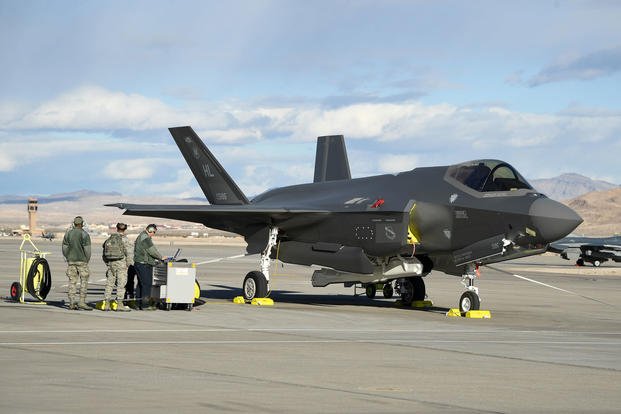Even though the F-35 program is making strides, each of the Joint Strike Fighter variants is still coming up short on combat readiness goals, according to the Pentagon's top weapons tester.
Based on collected data for fiscal 2019, the Air Force, Marine Corps and Navy variants all remain "below service expectations" for aircraft availability, Robert Behler, director of the Pentagon's Operational Test and Evaluation Office, said Wednesday.
"Operational suitability of the F-35 fleet remains below service expectations," he said before the House Subcommittee on Readiness and Tactical Air and Land Forces. "In particular, no F-35 variant meets the specified reliability or maintainability metrics."
One reason for falling short of the 65% availability rate goal is that "the aircraft are breaking more often and taking longer to fix," Behler added.
Related: Air Force Sees Unique Challenges in Deploying Stealth Fighters
Lawmakers requested that Behler; Ellen Lord, Under Secretary of Defense for Acquisition and Sustainment; Lt. Gen. Eric Fick, Program Executive Officer for the F-35 Joint Program Office; and Diana Maurer, director of Defense Capabilities and Management for the Government Accountability Office testify on sustainment, supply and production challenges affecting the program.
Results improved marginally from 2018 to 2019 but were still below the benchmark, and well below the 80% mission-capable rate goal set by Defense Secretary Jim Mattis in 2018.
Mattis ordered the services to raise mission-capable rates for four key tactical aircraft: the F-16 Fighting Falcon, the Navy's F/A-18 Hornet, the F-22 Raptor and the F-35. The objective was to achieve an 80% or higher mission-capable rate for each fleet by the end of fiscal 2019.
Units that deployed for overseas missions had better luck, Behler said.
"Individual units were able to achieve the 80% target for short periods during deployed operations," he said in his prepared testimony.
Fick backed up that claim. For example, he said, the 388th Fighter Wing from Hill Air Force Base, Utah, deployed to the Middle East as part of the F-35A's first rotation to the region. As a unit, the mission-capable rate for the jet fighters increased from 72% in April to 92% by the time they returned last month, he said.
Later in the hearing, Fick mentioned that a substantial contributor to the degraded mission capability rate -- the ability to perform a core mission function --is a deteriorated stealth coating on F-35 canopies.
In July, Defense Secretary Mark Esper told lawmakers the F-35 would fall short of the 80% mission-capable rate target over parts supply shortages to fix the crumbling coating that allows the plane to evade radar.
"[Canopy] supply shortages continue to be the main obstacle to achieving this," Esper said in written responses to the Senate Armed Services Committee prior to his confirmation. "We are seeking additional sources to fix unserviceable canopies."
Wednesday's hearing comes on the heels of a new Government Accountability Office report that once again urges the Defense Department to outline new policies to deal with the F-35's challenges.
"DoD's costs to purchase the F-35 are expected to exceed $406 billion, and the department expects to spend more than $1 trillion to sustain its F-35 fleet," the Nov. 13 report states. "Thus, DoD must continue to grapple with affordability as it takes actions to increase the readiness of the F-35 fleet and improve its sustainment efforts to deliver an aircraft that the military services and partner nations can successfully operate and maintain over the long term within their budgetary realities."
The 22-page report largely reiterated what the GAO found in April: that a lapse in supply chain management is one reason the F-35 stealth jet fleet, operated across three services, is falling short of its performance and operational requirements.
It's something the Pentagon and manufacturer Lockheed Martin need to work through as they gear up for another large endeavor. The DoD last month finalized a $34 billion agreement with the company for the next three batches of Joint Strike Fighters, firming up its largest stealth fighter jet deal to date.
The agreement includes 291 fifth-generation fighters for the U.S., 127 for international partners in the program, and 60 for foreign military sale customers.
-- Oriana Pawlyk can be reached at oriana.pawlyk@military.com. Follow her on Twitter at @Oriana0214.
Read more: Navy Denies Canceling Black Sea Op on Trump's Order












